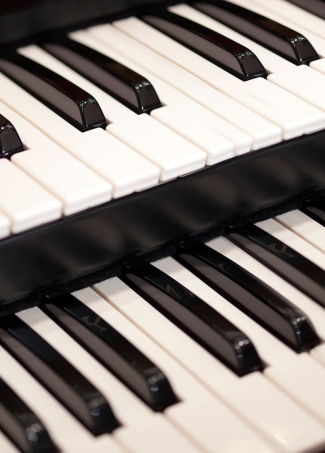Music Maker

Although Mr. Hubbard never counted himself as a professional musician in the strictest sense, his musical accomplishments are by no means insignificant. A radio balladeer in the 1930s, he once held a slot Arthur Godfrey would later fill, he would continue to compose and perform through the remainder of his life.
In the 1970s, he organized, instructed and orchestrated several performing groups and from this work comes a number of incisive essays, including: his analysis of Country Western, Flamenco, traditional Oriental and even Rock music (which he correctly observed was growing increasingly primitive). Notable among his own compositions through the period are his innovative blends of modern jazz, reggae and calypso, as well as his modern utilization of traditional Spanish and Oriental forms. Also highly innovative is his delineation of what he termed “the laws of proportionate sound,” wherein similar instruments of slightly different timbre were employed to overcome the long troublesome problem of instrumental cancellation, i.e., the sound of one instrument “wiping out” another regardless of volume. Although professionals have devised various remedies, Mr. Hubbard was factually the first to both dissect the problem and define its solution. The net effect of such musical innovation is most impressive. Indeed, wrote a critic of the day, L. Ron Hubbard solves “a problem the likes of which Buddy Rich and even Woody Herman failed to do. That is, focus the energy of a combo in a big band, a feat which is like harnessing the atom.”
The next L. Ron Hubbard offering was likewise both imaginative and innovative: a soundtrack for his bestselling novel, Battlefield Earth. Appropriately entitled Space Jazz, the album was the first to fully utilize the capabilities of the Fairlight Computer Musical Instrument. In particular, he employed the Fairlight to “sample” natural sounds and then presented those sounds through the keyboard as notes. Thus Space Jazz becomes a “tapestry” of gunshots, tinkling bottles and the like germane to the story—but all woven into percussion and rhythm. In all, the album features thirteen L. Ron Hubbard compositions, inspired by characters and significant events from his novel. The album additionally features performances by jazz legends Chick Corea and Stanley Clarke as well as the equally legendary Rolling Stones pianist Nicky Hopkins.
Given the biting satire inherent in the novel, Mr. Hubbard’s next work, Mission Earth, the album, is an appropriately hard-rock statement. The featured artist is an ever-innovative Edgar Winter and the album’s single, “Cry Out,” was later adopted by environmentalists as a marching song to halt unchecked pollution. But the album is particularly remembered for L. Ron Hubbard’s then wholly original use of “counter-rhythms”—being a second rhythm underlying the drums and typically at a lower pitch. Hence: “This counter-rhythm would surge exactly in the same way as the rest of the beat.” The result, as Winter himself remarked: “it slowly began to dawn on us that we were creating a whole new sound with a full symphonic backdrop to a surging rock ensemble.”
The final L. Ron Hubbard album, The Road to Freedom, reflects Mr. Hubbard’s oft repeated maxim, “Music is indeed the Universal Language.” In this case, he employs it to convey fundamental truths contained in Scientology. In that respect, the work stands as religious music in Scientology style. Again, the album features performances by Scientologists from the entertainment industry. The Road to Freedom further features a vocal performance by Mr. Hubbard himself on a final song, very appropriately entitled “Thank You for Listening.”
For the complete body of information on Mr. Hubbard’s musical legacy see the L. Ron Hubbard Series edition, Music Maker: Composer & Performer.

The L. Ron Hubbard Music Room containing his complete collection of musical instruments, including organs, synthesizers and an array of exotic items gathered from a lifetime of global travel





